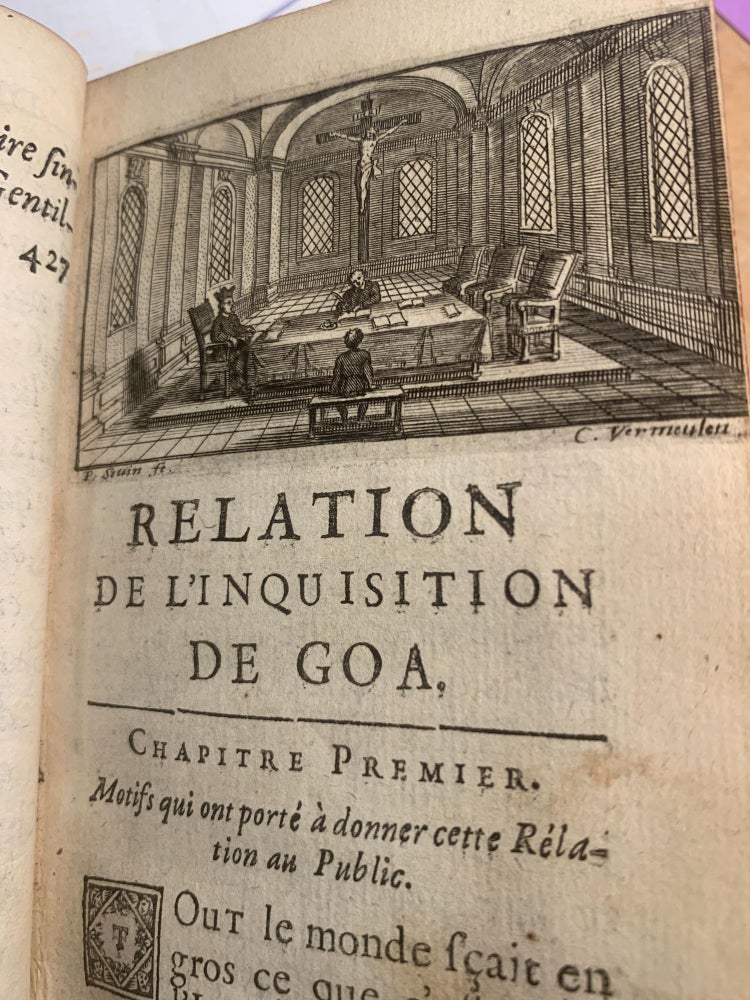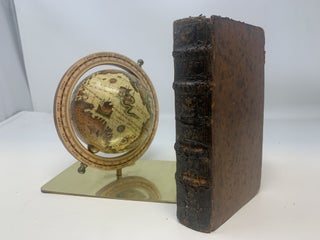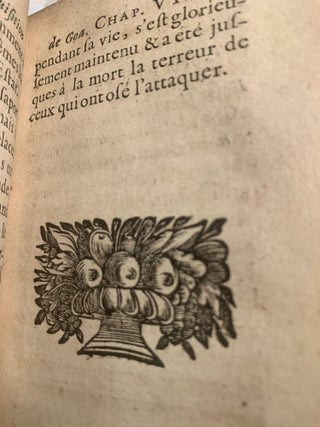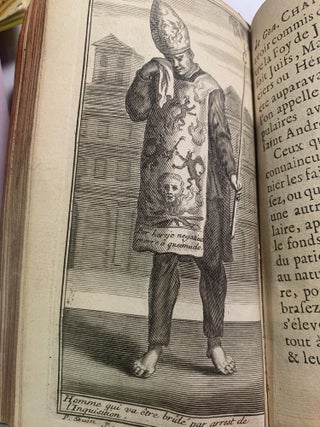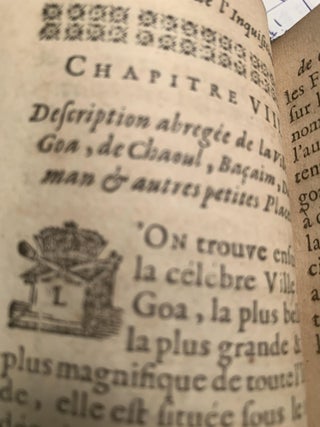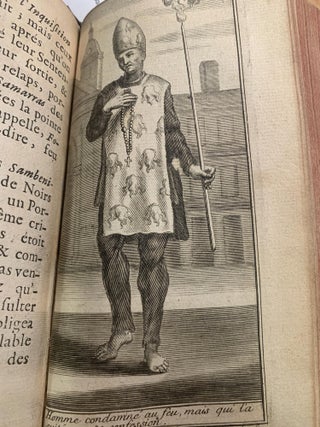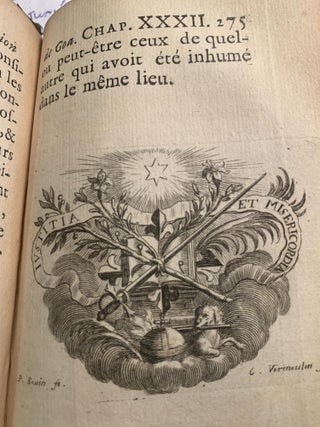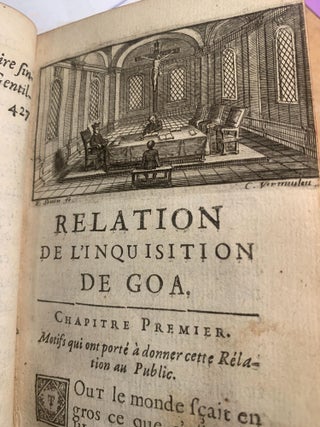RELATION DE L'INQUISITION DE GOA
Paris: Chez Daniel Horthemels, [1687] 1688. Cornelis Vermeulin. Second Edition. Leather-bound. In French: NOTE: LACKS TITLE PAGE (probably because it was a banned book (Index Librorum Prohibitorum), and like other such books throughout history, it was dangerous to be found with the "wrong" book, bible, etc. Published in Leyden in 1687 by Daniel Gaasbeek, without plates, and this (Paris) edition followed. An English translation was also published by James Knapton, in London later in 1688, entitled: "The History of The Inquisition, as it is Exercised at Goa. Written in French, by the Ingenious Monsieur Dellon, who laboured five years under those severities. With an Account of His Deliverance". Full spotted calf, 15 cm. 5 raised bands. Small chips missing from spine -- perhaps evidence of a fire. [26] 437, [25] pp Errata on last page after index and before extract du roi.
Title written in ink on free front end paper. 3 folding plates, several full page, and several heading chapter & dedication pages; The six engraved plates and several of the head- and tailpieces were created by Flemish printmaker and portraitist Cornelis Martinus Vermeulen (1644-1608) Book printed by Antoine Lambin in 1687.
"The three full-page plates depict heretics accused of different crimes wearing sanbenitos, i.e. special tunics that represent their fate: the Samarra, which is covered with dragons, devils, and flames surrounding an image of the heretic himself, signifying that the impenitent heretic was condemned to be burnt alive at the stake, the Fuego revolto, which is covered simply with flames pointing downwards, signifying that the heretic who became penitent after being condemned was not to be burnt alive at the stake, but was to have the mercy of being strangled before the fire was lit and the Sambenito featured red saltires, whose wearer was only to do penance The three folding plates show the following scenes: the procession of the Inquisition into a church, the Inquisition in session within a church and penitents being led from a church to be burned at the stake. The designs for the prints were made by Pierre Paul Sevin" (Wikipedia lookup for Cornelis Vermeulen)
The book was placed on the Index of Forbidden Books in 1690 "The book recounts the ordeal of Gabriel Dellon, a French Roman Catholic physician who had traveled in the Indies where he was arrested, tortured and, refusing to confess under such duress, was convicted to the galleys by the Inquisition in Goa..." 'The inquisition was introduced into Goa in 1560: a vivid account of its proceedings in given by G. Dellon. ---Enc. Britannica. On the Index of Prohibited Books. Interesting geometric bookplate of Georges Roffavier, the 19th century French botanist. Very Good. Item #81041
"...an extension of the Portuguese Inquisition in Portuguese India. Its objective was to enforce Catholic Orthodoxy and allegiance to the Apostolic See of Rome (Pontifex). The inquisition primarily focused on the New Christians accused of secretly practicing their former religions, and Old Christians accused of involvement in the Protestant Revolution of the 16th century.[1] It was established in 1560, briefly suppressed from 1774 to 1778, continued thereafter until it was finally abolished in 1812. Those targeted were predominately accused of crypto-Hinduism.Those accused were imprisoned and depending on the criminal charge, could even be sentenced to death if convicted.The Inquisitors also seized and burnt any books written in Sanskrit, Dutch, English, or Konkani, on the suspicions that they contained deviationist or Protestant material The aims of the Portuguese empire in Asia were combating Islam, spreading Christianity, and trading spices. The Portuguese were guided by missionary fervour and intolerance..." (Wikipedia)
"The Index Librorum Prohibitorum ("List of Prohibited Books") was a list of publications deemed heretical or contrary to morality by the Sacred Congregation of the Index (a former Dicastery of the Roman Curia), and Catholics were forbidden to read them.[1] There were attempts to ban heretical books before the sixteenth century, notably in the ninth-century Decretum Glasianum; the Index of Prohibited Books of 1560 banned thousands of book titles and blacklisted publications, including the works of Europe's intellectual elitesThe 20th and final edition of the index appeared in 1948, and the Index was formally abolished on 14 June 1966 by Pope Paul VI. The Index condemned religious and secular texts alike, grading works by the degree to which they were seen to be repugnant to the church. The aim of the list was to protect church members from reading theologically, culturally, or politically disruptive books. Such books included works by astronomers, such as the German Johannes Kepler's Epitome Astronomiae Copernicanae (published in three volumes from 1618 to 1621), which was on the Index from 1621 to 1835, works by philosophers, such as the Prussian Immanuel Kant's Critique of Pure Reason (1781), and editions and translations of the Bible that had not been approved. Editions of the Index also contained the rules of the Church relating to the reading, selling, and preemptive censorship of books..."(Wikipedia).
Price: $950.00


